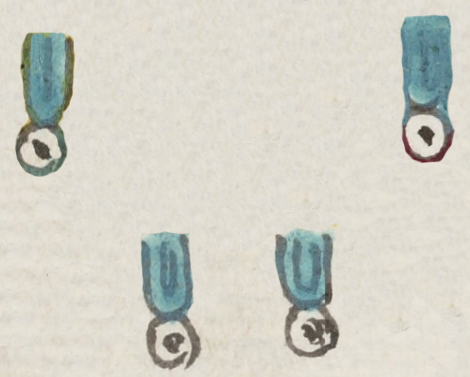quiyahuitl (Mdz16r)
This element for rain (quiyahuitl) has been carved from the compound sign for the place name, Tlachquiyauhco. It consists of a symmetrical arrangement of four short streams of water, painted turquoise blue. Each stream has black lines inside it, seemingly intending to show current or flow. The staggering of these raindrops at different heights provides another type of visual movement, as though they are falling through the air. At the end of each stream is a droplet, not painted blue but left white, and consisting of small concentric circles. They fall from an unknown source, as though suspended in air.
Stephanie Wood
The visual relationship between rain (quiyahuitl) and water (atl) is not a coincidence. Variations will occur, but this is a classic representation of rain, and we have a few compound glyphs in this collection that indicate the importance of rain. As our online Nahuatl Dictionary entry for quiyahuitl shows, there was a strong relationship between tears and raindrops. When children cried, people believed that to be a sign that it would rain. Rainfall had a strong association with the deity or priest called Tlaloc, who could bring on the rain and facilitate fertility in agriculture (Florentine Codex, Book 1). Tlaloc wore a necklace of green stones, which also symbolized water or precious raindrops.
Besides the fact that rain is essential for agricultural success in many parts of the Nahua world, and probably because of that, the term quiyahuitl is a day name in the divinatory calendar. But in the compound from which this element derives, rain may have been playing a phonetic role for -quiyahuac (outside or at the entrance--to the ball court).
Stephanie Wood
c. 1541, but by 1553 at the latest
Xitlali Torres
agua, aguacero, lluvia, entrada

Codex Mendoza, folio 16 recto, https://digital.bodleian.ox.ac.uk/objects/2fea788e-2aa2-4f08-b6d9-648c00..., image 42 of 188.
The Bodleian Libraries, University of Oxford, hold the original manuscript, the MS. Arch. Selden. A. 1. This image is published here under the UK Creative Commons, “Attribution-NonCommercial-ShareAlike 3.0 License” (CC-BY-NC-SA 3.0).

